SPACE
Scientists Found Carbon in an Ancient Place Where It Was Never Supposed to Be
Darren Orf
Thu, June 13, 2024
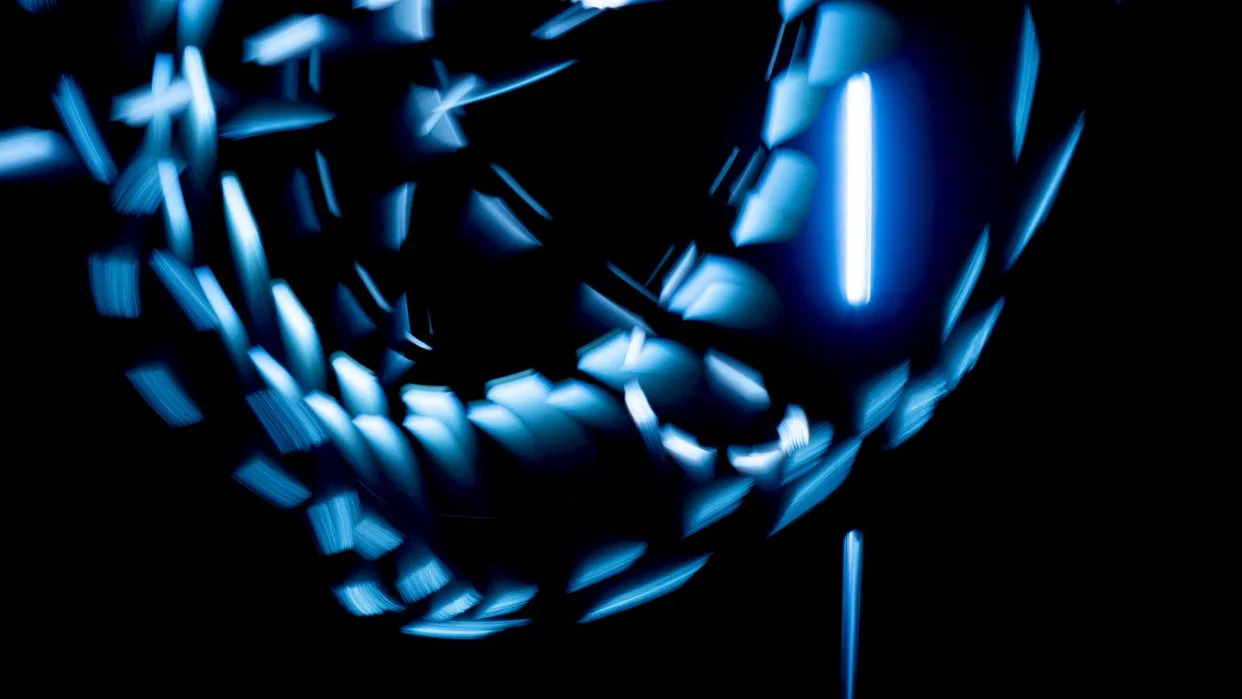
Life May Have Kicked Off Earlier Than We Thought
Andrew Griffin
Fri, June 14, 2024
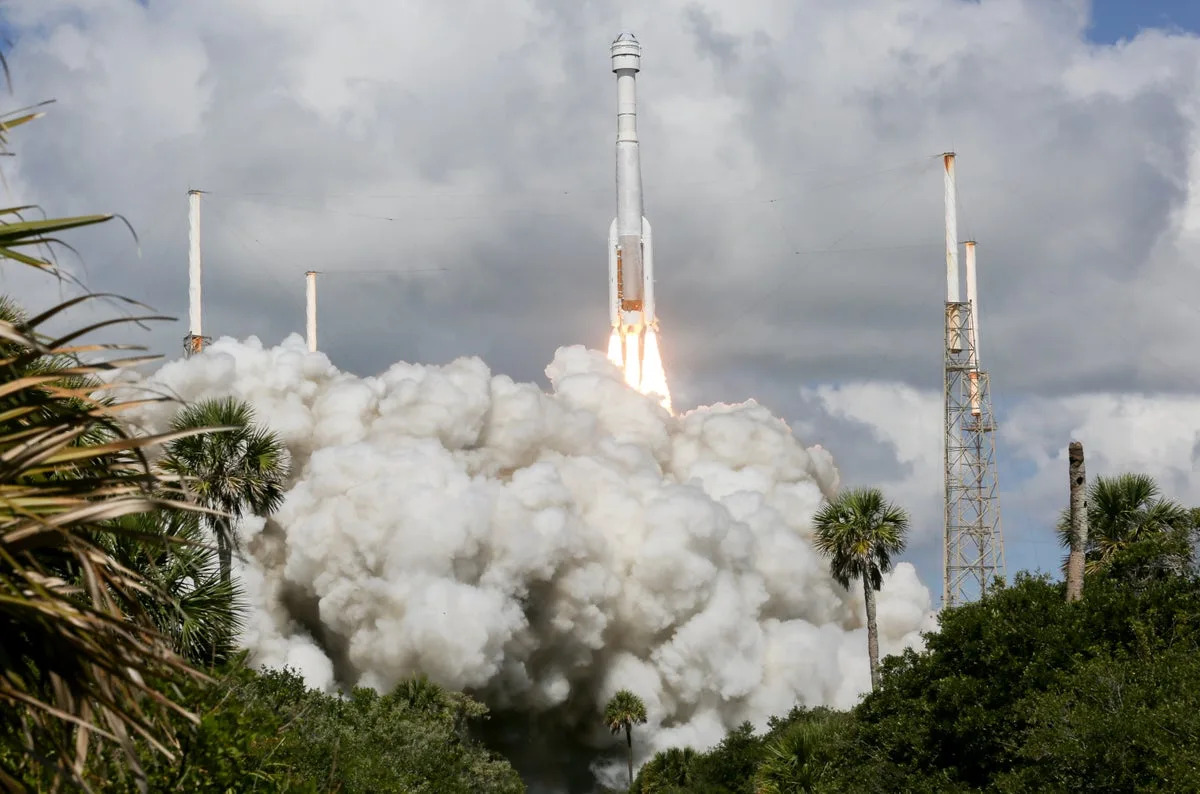
Boeing Starliner not ready to come back to Earth – leaving astronauts on International Space Station
Boeing’s troubled Starliner spacecraft will stay at the International Space Station for longer than expected, just the latest in a series of problems for the capsule.
It means that the astronauts who were carried to the space station in a mission earlier this month will have to stay for longer than expected, coming back on 22 June. They may end up staying for longer.
Nasa said that the delayed return will allow Nasa and Boeing to spend more time planning for the astronauts’ return and their journey back down to Earth.
Nasa astronauts Butch Wilmore and Suni Williams were launched aboard Starliner June 5 and arrived at the ISS the next day, following a 24-hour flight in which the spacecraft encountered four helium leaks and five failures of its 28 manoeuvring thrusters.
“The extra time allows the team to finalise departure planning and operations while the spacecraft remains cleared for crew emergency return scenarios within the flight rules,” Nasa and Boeing said in a statement.
They are targeting a departure no earlier than June 22, leaving open an opportunity for further extensions of time at the ISS. Starliner, while designed for future six-month missions, can stay docked to the ISS for a maximum of 45 days during its current mission.
The return to Earth is expected to last about six hours and target a location in the desert of Utah, New Mexico or other backup locations, depending on local weather conditions.
Starliner‘s first flight with astronauts is a crucial last test in a much-delayed and over-budget program before Nasa can certify the spacecraft for routine astronaut missions and add a second US crew vehicle to its fleet, alongside SpaceX’s Crew Dragon.
The spacecraft during its time docked to the ISS has encountered more problems. A fifth leak of helium - used to pressurize Starliner‘s propulsion system thrusters - popped up, and separately an oxidizer valve has been stuck, Nasa has said.
Those in-flight problems follow years of other challenges Boeing has faced with Starliner, including a 2019 uncrewed test failure where dozens of software glitches, design problems and management issues nixed its ability to dock to the ISS. A 2022 repeat uncrewed test succeeded to dock.
If all goes as planned with Starliner‘s return of two astronauts back to Earth, Boeing still faces other challenges before making the spacecraft operational and bringing it to market for other non-Nasa customers.
Boeing's Starliner astronaut taxi spotted at ISS (satellite photo)
Mike Wall
Fri, June 14, 2024
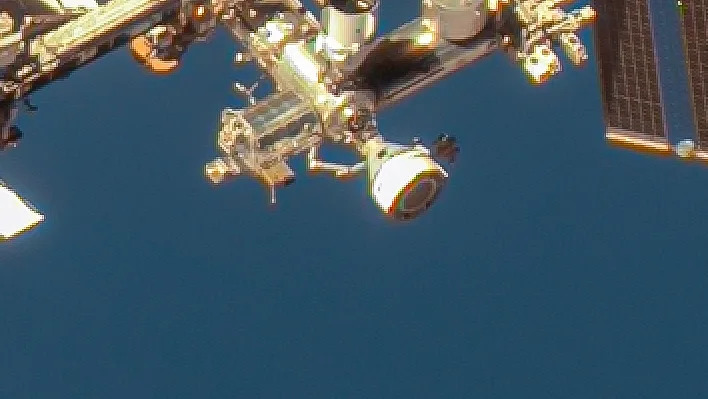
Boeing's Starliner capsule is seen docked to the International Space Station in this zoomed-in view of an image captured by Maxar Technologies' WorldView-3 satellite on June 7, 2024. | Credit: Maxar Technologies
An Earth-observing satellite has given us a unique view of Boeing's new Starliner astronaut taxi in space.
Starliner arrived at the International Space Station (ISS) on June 6, delivering NASA astronauts Butch Wilmore and Suni Williams to the orbiting lab on a shakeout cruise known as Crew Flight Test (CFT).
A day later, Maxar Technologies' WorldView-3 satellite snapped a striking photo of the ISS and its new arrival, which is prominently featured near the center of the frame.
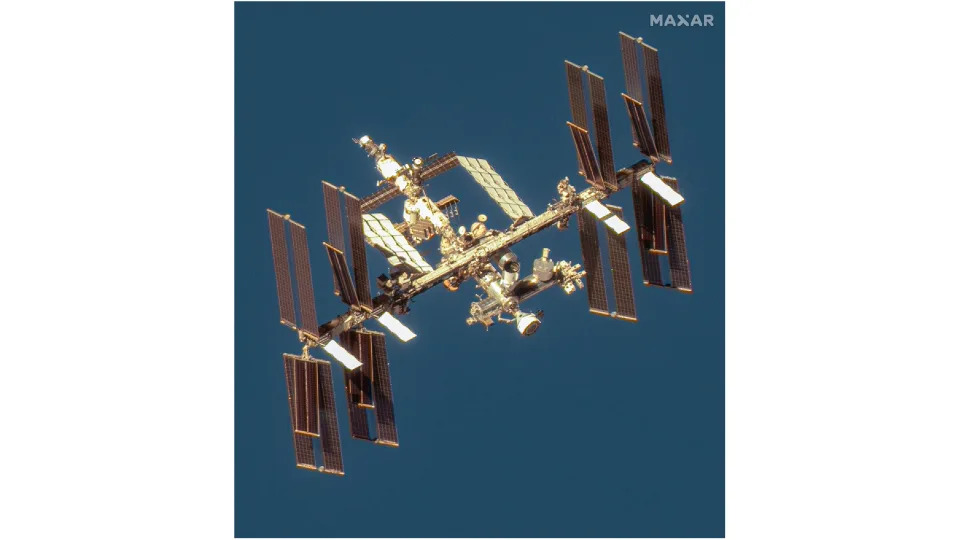
a white space capsule is seen docked to the international space station in this satellite photo
WorldView-3, which launched in August 2014, usually observes Earth from its vantage point 385 miles (620 kilometers) above our planet. But the new photo shows that the spacecraft can study objects in orbit as well.
"This type of imagery collection, known as non-Earth imaging (NEI), is a breakthrough capability that enables Maxar to support critical space domain awareness missions for government and commercial customers," Maxar wrote in an X post on Wednesday (June 12) that featured the ISS-Starliner photo.
Non-Earth imaging could become a higher and higher priority for the U.S. government and other entities with a large stake in the final frontier over the coming years.
The number of satellites going to orbit has jumped dramatically recently and will likely continue to grow, largely due to the rise of megaconstellations such as SpaceX's Starlink broadband network, which currently consists of more than 6,000 active spacecraft. Keeping tabs on this ever-growing orbital population will likely become increasingly important, and increasingly challenging, for satellite operators.
RELATED STORIES:
— Thruster glitches and helium leaks can't stop Boeing's Starliner astronaut test flight — but why are they happening?
— Meet the crew launching on Boeing's 1st Starliner astronaut flight
— 2 astronaut taxis: Why NASA wants both Boeing's Starliner and SpaceX's Dragon
CFT is the first-ever crewed mission for Starliner, which is scheduled to come back to Earth no earlier than June 18. If all goes well on the mission, the capsule will be certified to fly long-duration astronaut missions to and from the ISS for NASA.
SpaceX already does this with its Crew Dragon capsule and Falcon 9 rocket. Elon Musk's company is in the middle of its eighth operational astronaut flight to the ISS, known as Crew-8.
NON SCIENTIST CHEERLEADER
Darren Orf
Thu, June 13, 2024

Life May Have Kicked Off Earlier Than We Thought
Aitor Diago - Getty Images
Scientists estimate that the universe garnered enough carbon to form planets some one billion years after the Big Bang.
But that timeline might be a bit more complicated—a new study analyzing a primordial galaxy named GS-z12, which formed 350 million years after the Big Bang, contained clouds of carbon.
This could indicate that early stars released less energy than expected when going supernova, and instead released their outer carbon shells rather than consuming the element in a black hole.
The nonmetallic chemical element carbon is the essential building block of all life (at least on Earth). Because the element can combine with so many other elements—including itself, hydrogen, oxygen, nitrogen, and more—carbon is seen as required for complex life to take shape.
During the early (millions of) years after the Big Bang, no carbon existed, because the early universe contained only light elements like hydrogen and helium (as well as trace amounts of lithium). Scientists estimate that the heavy element-engines, which were the very first stars, likely churned out enough carbon to form planets around one billion years after the Big Bang.
However, scientists from the University of Cambridge are altering that timeline significantly after analyzing data from the James Webb Space Telescope (JWST). In that data lurked an ancient galaxy named GS-z12—one of the most distant ever observed at some 13 billion light-years away—in which the experts discovered traces of clouds of carbon. Accepted for publication by the Astronomy & Astrophysics and posted to the preprint server arXiv, the study could prove that carbon was present in the universe as early as 350 million years after the Big Bang.
“Earlier research suggested that carbon started to form in large quantities relatively late – about one billion years after the Big Bang,” Roberto Maiolino, a co-author of the study, said in a press statement. “But we’ve found that carbon formed much earlier – it might even be the oldest metal of all.”
JWST’s Near Infrared Spectrograph, or NIRSpec, allows the groundbreaking space telescope to analyze light from this galaxy in a spectrum of colors. This is particularly important because GS-z12 is both incredibly faint and 100,000 times less massive than our own Milky Way. Luckily, while JWST spends hundreds of hours gathering light from this distant corner of the universe, it also uses its microshutter array to glimpse other objects at the same time.
Because elements leave behind different chemical fingerprints in this infrared spectrum, scientists can analyze the data and determine what exactly makes up this early galaxy. The scientists clearly found traces of carbon, as well as oxygen and neon. This discovery could make scientists rethink the role of early stars in the universe.
“We were surprised to see carbon so early in the universe, since it was thought that the earliest stars produced much more oxygen than carbon,” Maiolino said in a press statement. “We had thought that carbon was enriched much later, through entirely different processes, but the fact that it appears so early tells us that the very first stars may have operated very differently.”
One explanation, according to the researchers, is that early stars released less energy when going supernova than initially believed. This might’ve allowed carbon—likely contained in the stars’ outer shells—to quickly seed the universe, rather than being consumed by a collapsing black hole.
This means life might’ve gotten quite the headstart on the timeline we have long believed to be true. And while that life might look much different than our own, we can likely bet on one thing—it was probably made of carbon.
Scientists estimate that the universe garnered enough carbon to form planets some one billion years after the Big Bang.
But that timeline might be a bit more complicated—a new study analyzing a primordial galaxy named GS-z12, which formed 350 million years after the Big Bang, contained clouds of carbon.
This could indicate that early stars released less energy than expected when going supernova, and instead released their outer carbon shells rather than consuming the element in a black hole.
The nonmetallic chemical element carbon is the essential building block of all life (at least on Earth). Because the element can combine with so many other elements—including itself, hydrogen, oxygen, nitrogen, and more—carbon is seen as required for complex life to take shape.
During the early (millions of) years after the Big Bang, no carbon existed, because the early universe contained only light elements like hydrogen and helium (as well as trace amounts of lithium). Scientists estimate that the heavy element-engines, which were the very first stars, likely churned out enough carbon to form planets around one billion years after the Big Bang.
However, scientists from the University of Cambridge are altering that timeline significantly after analyzing data from the James Webb Space Telescope (JWST). In that data lurked an ancient galaxy named GS-z12—one of the most distant ever observed at some 13 billion light-years away—in which the experts discovered traces of clouds of carbon. Accepted for publication by the Astronomy & Astrophysics and posted to the preprint server arXiv, the study could prove that carbon was present in the universe as early as 350 million years after the Big Bang.
“Earlier research suggested that carbon started to form in large quantities relatively late – about one billion years after the Big Bang,” Roberto Maiolino, a co-author of the study, said in a press statement. “But we’ve found that carbon formed much earlier – it might even be the oldest metal of all.”
JWST’s Near Infrared Spectrograph, or NIRSpec, allows the groundbreaking space telescope to analyze light from this galaxy in a spectrum of colors. This is particularly important because GS-z12 is both incredibly faint and 100,000 times less massive than our own Milky Way. Luckily, while JWST spends hundreds of hours gathering light from this distant corner of the universe, it also uses its microshutter array to glimpse other objects at the same time.
Because elements leave behind different chemical fingerprints in this infrared spectrum, scientists can analyze the data and determine what exactly makes up this early galaxy. The scientists clearly found traces of carbon, as well as oxygen and neon. This discovery could make scientists rethink the role of early stars in the universe.
“We were surprised to see carbon so early in the universe, since it was thought that the earliest stars produced much more oxygen than carbon,” Maiolino said in a press statement. “We had thought that carbon was enriched much later, through entirely different processes, but the fact that it appears so early tells us that the very first stars may have operated very differently.”
One explanation, according to the researchers, is that early stars released less energy when going supernova than initially believed. This might’ve allowed carbon—likely contained in the stars’ outer shells—to quickly seed the universe, rather than being consumed by a collapsing black hole.
This means life might’ve gotten quite the headstart on the timeline we have long believed to be true. And while that life might look much different than our own, we can likely bet on one thing—it was probably made of carbon.
Boeing Starliner not ready to come back to Earth – leaving astronauts on International Space Station
Andrew Griffin
Fri, June 14, 2024

Boeing Starliner not ready to come back to Earth – leaving astronauts on International Space Station
Boeing’s troubled Starliner spacecraft will stay at the International Space Station for longer than expected, just the latest in a series of problems for the capsule.
It means that the astronauts who were carried to the space station in a mission earlier this month will have to stay for longer than expected, coming back on 22 June. They may end up staying for longer.
Nasa said that the delayed return will allow Nasa and Boeing to spend more time planning for the astronauts’ return and their journey back down to Earth.
Nasa astronauts Butch Wilmore and Suni Williams were launched aboard Starliner June 5 and arrived at the ISS the next day, following a 24-hour flight in which the spacecraft encountered four helium leaks and five failures of its 28 manoeuvring thrusters.
“The extra time allows the team to finalise departure planning and operations while the spacecraft remains cleared for crew emergency return scenarios within the flight rules,” Nasa and Boeing said in a statement.
They are targeting a departure no earlier than June 22, leaving open an opportunity for further extensions of time at the ISS. Starliner, while designed for future six-month missions, can stay docked to the ISS for a maximum of 45 days during its current mission.
The return to Earth is expected to last about six hours and target a location in the desert of Utah, New Mexico or other backup locations, depending on local weather conditions.
Starliner‘s first flight with astronauts is a crucial last test in a much-delayed and over-budget program before Nasa can certify the spacecraft for routine astronaut missions and add a second US crew vehicle to its fleet, alongside SpaceX’s Crew Dragon.
The spacecraft during its time docked to the ISS has encountered more problems. A fifth leak of helium - used to pressurize Starliner‘s propulsion system thrusters - popped up, and separately an oxidizer valve has been stuck, Nasa has said.
Those in-flight problems follow years of other challenges Boeing has faced with Starliner, including a 2019 uncrewed test failure where dozens of software glitches, design problems and management issues nixed its ability to dock to the ISS. A 2022 repeat uncrewed test succeeded to dock.
If all goes as planned with Starliner‘s return of two astronauts back to Earth, Boeing still faces other challenges before making the spacecraft operational and bringing it to market for other non-Nasa customers.
Boeing's Starliner astronaut taxi spotted at ISS (satellite photo)
Mike Wall
Fri, June 14, 2024

Boeing's Starliner capsule is seen docked to the International Space Station in this zoomed-in view of an image captured by Maxar Technologies' WorldView-3 satellite on June 7, 2024. | Credit: Maxar Technologies
An Earth-observing satellite has given us a unique view of Boeing's new Starliner astronaut taxi in space.
Starliner arrived at the International Space Station (ISS) on June 6, delivering NASA astronauts Butch Wilmore and Suni Williams to the orbiting lab on a shakeout cruise known as Crew Flight Test (CFT).
A day later, Maxar Technologies' WorldView-3 satellite snapped a striking photo of the ISS and its new arrival, which is prominently featured near the center of the frame.

a white space capsule is seen docked to the international space station in this satellite photo
WorldView-3, which launched in August 2014, usually observes Earth from its vantage point 385 miles (620 kilometers) above our planet. But the new photo shows that the spacecraft can study objects in orbit as well.
"This type of imagery collection, known as non-Earth imaging (NEI), is a breakthrough capability that enables Maxar to support critical space domain awareness missions for government and commercial customers," Maxar wrote in an X post on Wednesday (June 12) that featured the ISS-Starliner photo.
Non-Earth imaging could become a higher and higher priority for the U.S. government and other entities with a large stake in the final frontier over the coming years.
The number of satellites going to orbit has jumped dramatically recently and will likely continue to grow, largely due to the rise of megaconstellations such as SpaceX's Starlink broadband network, which currently consists of more than 6,000 active spacecraft. Keeping tabs on this ever-growing orbital population will likely become increasingly important, and increasingly challenging, for satellite operators.
RELATED STORIES:
— Thruster glitches and helium leaks can't stop Boeing's Starliner astronaut test flight — but why are they happening?
— Meet the crew launching on Boeing's 1st Starliner astronaut flight
— 2 astronaut taxis: Why NASA wants both Boeing's Starliner and SpaceX's Dragon
CFT is the first-ever crewed mission for Starliner, which is scheduled to come back to Earth no earlier than June 18. If all goes well on the mission, the capsule will be certified to fly long-duration astronaut missions to and from the ISS for NASA.
SpaceX already does this with its Crew Dragon capsule and Falcon 9 rocket. Elon Musk's company is in the middle of its eighth operational astronaut flight to the ISS, known as Crew-8.
NASA administrator says 'at least a trillion' other planets like Earth could exist in universe
Bret Baier
Bret Baier, Amy Munneke
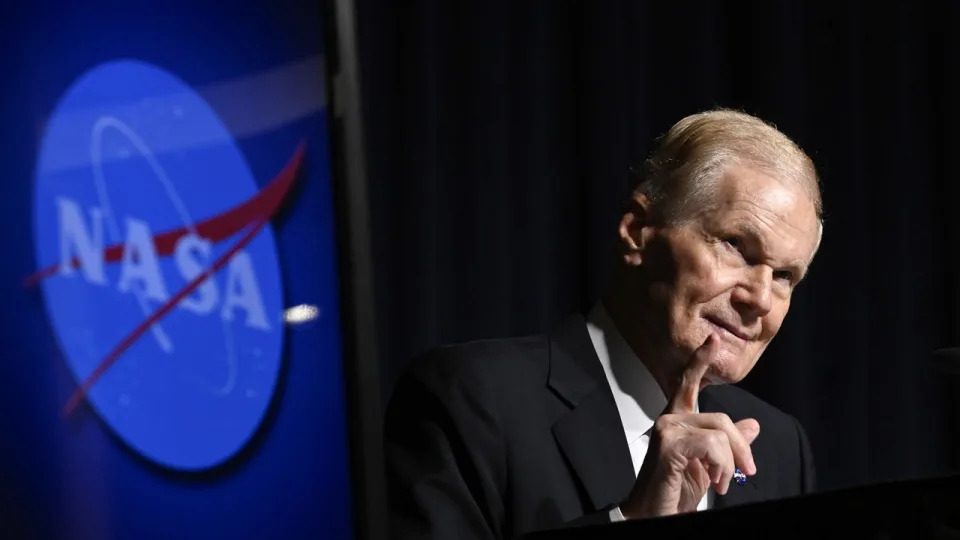
NASA Administrator Bill Nelson speaks during a media briefing at NASA headquarters in Washington, D.C., on Sept. 14, 2023.
Nelson said space is part of the American spirit and making the impossible possible.
"We choose to go to the moon in this decade and do the other things, not because they are easy, but because they are hard," President John F. Kennedy said during a speech at Rice University in 1962.
Kennedy’s speech has helped inspire decades of research at NASA. When the agency was created in 1958, Congress put into law that any technology created for space must also be practical for earth.
"Since 1958, we've been spinning off these technologies to the public in the forms of new products and services that make our lives better," said NASA Technology Transfer Program Executive Daniel Lockney. "[The technologies] enhance the U.S. economy, save lives and in other instances are just really cool things that we get as a result of the nation's investment in this aerospace research."
Lockney has worked to transfer NASA inventions or intellectual property to the public sector.
"We get credit for things that we didn't do, which is a wonderful problem to have," Lockney said. "Something we did do that we don't get credit for is, we invented the camera that's in your cellphone."
In the 1980s, spacecraft imaging helped launch the digital camera industry using charged devices to create pictures in space. By the next decade, NASA’s Jet Propulsion Lab in California worked to create image sensors that used less power and were easier to mass-produce. The result was a small digital computer chip.
"We didn't know what to do with it," Lockney said. "Then, Nokia approached us, and they had this wacky idea of putting a camera in a telephone."
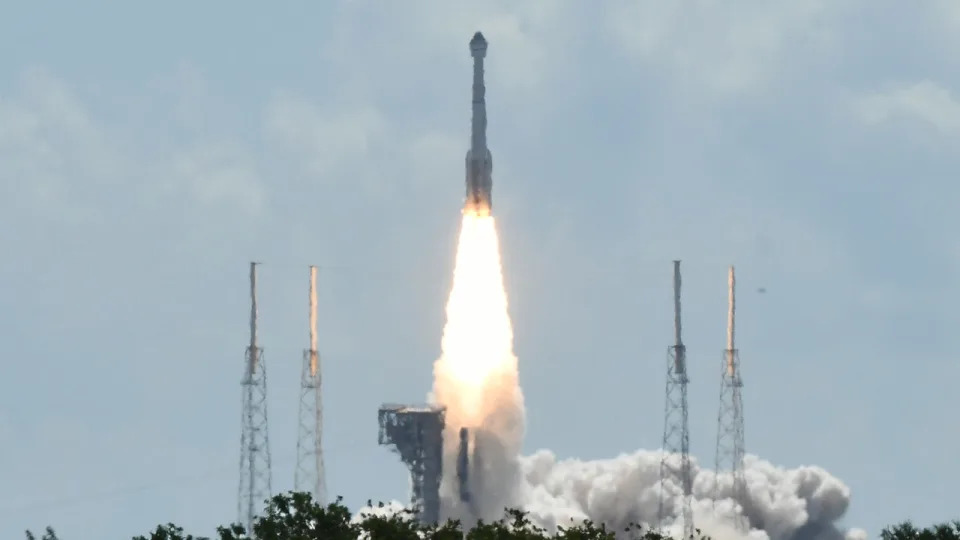
A United Launch Alliance Atlas V rocket carrying Boeing's CST-100 Starliner spacecraft launches from pad 41 at Cape Canaveral Space Force Station on June 5, 2024, in Cape Canaveral, Florida. NASA administrator Bill Nelson says public-private partnerships in space are helping unite Americans.
The lightweight, high-resolution camera microchip didn’t require a lot of power and was perfect for spaceflight and handheld personal devices.
"Now, we all have the blessing of taking with our camera a photograph, and it's an absolutely beautiful photograph," Nelson said.
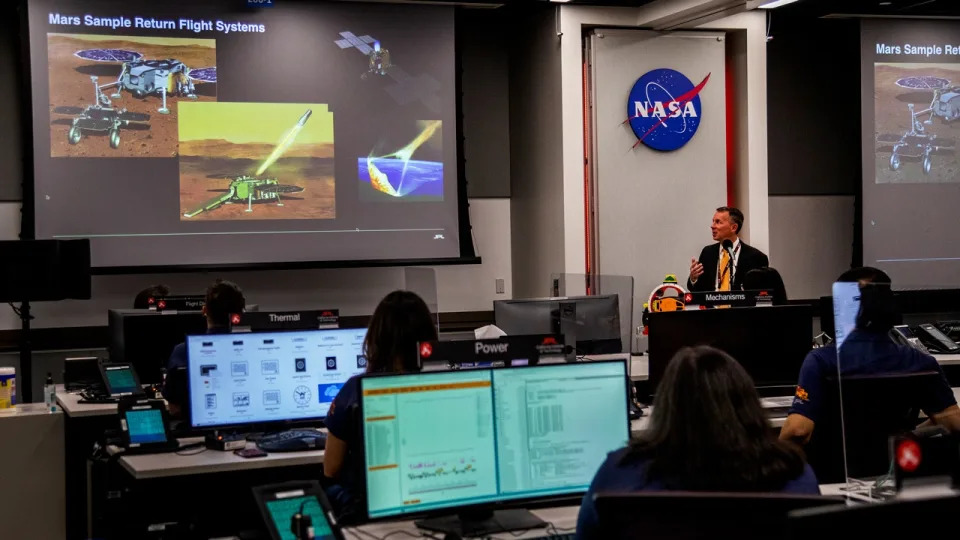
Bobby Braun, director for planetary science at NASA's Jet Propulsion Laboratory (JPL), discusses Mars sample return flight systems on Oct. 14, 2021, at the JPL in Pasadena, California.
New technology is being developed on Earth to advance space flight, but an increasing amount of research and innovation is being done in space. Nelson says astronauts are experimenting at the International Space Station 24/7. Private companies also have been sending astronauts into space for experimenting.
"The additional astronauts coming up are bringing their own [research], many of them sponsored by pharmaceutical companies to do their own. Whenever they want to send it up for much longer, we have our astronauts up there full time," he said.
Bret Baier
FOX NEWS
Thu, June 13, 2024
NASA has plans to return astronauts to the lunar surface in the near future. Next year, four astronauts will orbit the moon.
"We don't need to go back to the moon just for the moon. We're going back to learn new things. In order for us to go to Mars and beyond," said Administrator Bill Nelson.
The Perseverance Rover is exploring the Jezero Crater on Mars, which was once a lake on the red planet. Scientists believe life may have existed there in the distant past.
LUNAR MINING RAISES KEY LEGAL QUESTIONS AS NEW SPACE RACE HEATS UP
"It's getting samples and it's drilling with this drill, creating these core samples about the size of a cigar and sealing them up in these titanium tubes," Nelson explained. "We're trying to figure out right now how we're going to go back and get them and bring them back to Earth, so that we got an idea of whether or not there was life there."
NASA is now working with several companies to develop a plan for the return mission, which could happen in the 2030s. The agency is also working with Firebird Diagnostics in the search for life on Mars.
"NASA's mission is to go out, among other things, and discover whether or not we are alone," said Firebird Diagnostics Founder Steven Benner.
His company sells so-called alien DNA. It uses synthetic properties and has helped NASA understand what possible forms of alternative DNA might exist.
US-CHINA SPACE RACE FOR MOON MINING HEATS UP
"It's a big question as to how molecular biology could be done if it was, done by an organism that does not share a common ancestor, a common origin, with you and me," Benner said.
The DNA has also helped detect diseases like Covid-19, cancer and HIV here on Earth. Human DNA has four nucleotides or building blocks. Benner’s synthetic material has up to eight. They allow for more sensitive testing and eliminate false positives.
"It allows you to get that needle in the haystack without having to worry about all the background information," Benner said.
Nelson says searching for life on other planets helps us understand better who we are in the universe.
DIA OFFICIALS WARN CHINA, RUSSIA DEVELOPING 'COUNTER-SPACE CAPABILITIES'
"If you ask me directly, do I think that there are aliens here on Earth? I don't think so. I don't absolutely know. And I don't think the U.S. government is hiding anything from anybody. But if you ask me, ‘do I think there's life out there in the cosmos?,’" Nelson said. "I ask our NASA scientists that question, ‘how many possibilities in the vastness of this universe are there, that there's another planet like Earth that would be habitable for life as something like we know it?’ They said at least a trillion."
Nelson says while the odds that life may exist in space, whatever it may be, likely exists so far away that it won’t be discovered for a long time. However, NASA is still preparing for the possibility.
"Even if you could travel at the speed of light to a far off distant world, the close ones are a thousand light years away," Nelson said. "That doesn't mean that we cannot have some kind of understanding of what's out there."
Nelson has asked NASA scientists to use artificial intelligence in the software of spacecrafts.
"In a spacecraft like Voyager, that is out in interstellar space, that is beyond our solar system, if it came upon another spacecraft, it could real time learn to communicate with that other spacecraft," Nelson said. "That’s what we do at NASA. They make the impossible possible. It's a bunch of wizards around here."
NASA administrator describes future projects, partnerships in space
Thu, June 13, 2024
NASA has plans to return astronauts to the lunar surface in the near future. Next year, four astronauts will orbit the moon.
"We don't need to go back to the moon just for the moon. We're going back to learn new things. In order for us to go to Mars and beyond," said Administrator Bill Nelson.
The Perseverance Rover is exploring the Jezero Crater on Mars, which was once a lake on the red planet. Scientists believe life may have existed there in the distant past.
LUNAR MINING RAISES KEY LEGAL QUESTIONS AS NEW SPACE RACE HEATS UP
"It's getting samples and it's drilling with this drill, creating these core samples about the size of a cigar and sealing them up in these titanium tubes," Nelson explained. "We're trying to figure out right now how we're going to go back and get them and bring them back to Earth, so that we got an idea of whether or not there was life there."
NASA is now working with several companies to develop a plan for the return mission, which could happen in the 2030s. The agency is also working with Firebird Diagnostics in the search for life on Mars.
"NASA's mission is to go out, among other things, and discover whether or not we are alone," said Firebird Diagnostics Founder Steven Benner.
His company sells so-called alien DNA. It uses synthetic properties and has helped NASA understand what possible forms of alternative DNA might exist.
US-CHINA SPACE RACE FOR MOON MINING HEATS UP
"It's a big question as to how molecular biology could be done if it was, done by an organism that does not share a common ancestor, a common origin, with you and me," Benner said.
The DNA has also helped detect diseases like Covid-19, cancer and HIV here on Earth. Human DNA has four nucleotides or building blocks. Benner’s synthetic material has up to eight. They allow for more sensitive testing and eliminate false positives.
"It allows you to get that needle in the haystack without having to worry about all the background information," Benner said.
Nelson says searching for life on other planets helps us understand better who we are in the universe.
DIA OFFICIALS WARN CHINA, RUSSIA DEVELOPING 'COUNTER-SPACE CAPABILITIES'
"If you ask me directly, do I think that there are aliens here on Earth? I don't think so. I don't absolutely know. And I don't think the U.S. government is hiding anything from anybody. But if you ask me, ‘do I think there's life out there in the cosmos?,’" Nelson said. "I ask our NASA scientists that question, ‘how many possibilities in the vastness of this universe are there, that there's another planet like Earth that would be habitable for life as something like we know it?’ They said at least a trillion."
Nelson says while the odds that life may exist in space, whatever it may be, likely exists so far away that it won’t be discovered for a long time. However, NASA is still preparing for the possibility.
"Even if you could travel at the speed of light to a far off distant world, the close ones are a thousand light years away," Nelson said. "That doesn't mean that we cannot have some kind of understanding of what's out there."
Nelson has asked NASA scientists to use artificial intelligence in the software of spacecrafts.
"In a spacecraft like Voyager, that is out in interstellar space, that is beyond our solar system, if it came upon another spacecraft, it could real time learn to communicate with that other spacecraft," Nelson said. "That’s what we do at NASA. They make the impossible possible. It's a bunch of wizards around here."
NASA administrator describes future projects, partnerships in space
Bret Baier, Amy Munneke
FOX NEWS
Thu, June 13, 2024
Bill Nelson says he never imagined he would become administrator of the nation’s space agency, NASA.
"I had no idea," Nelson said. "As a matter of fact, I grew up in the shadow of the cape, never thinking I would ever have a chance to fly in space."
Nelson served in both the House and Senate as a Democrat representing Florida. In 1986, Nelson trained and flew with the crew of the space shuttle Columbia and became the second sitting member of Congress to travel to space, after Sen. Jake Garn, R-Utah.
CRAZY-STRONG ROBOTIC DOGS GEAR UP FOR MOON MISSION
"I flew in the space shuttle. We had 135 flights, two that were catastrophic. The first one, Challenger, was 10 days after our flight landed back on Earth," Nelson said. "It's an unforgiving environment. And there you are, white-knuckle time when that baby's going up and when it's coming back."
The space shuttle completed its final mission in 2011. Since then, NASA has begun working with an increasing number of private companies to travel and conduct research in space. He says the partnerships have helped unite Americans.
"Just think how the space history here brought us together. Think when the Soviets beat us, and we were scared because they had the high ground. They had Sputnik, and then they got Yuri Gagarin up first for one orbit," Nelson said. "But [a few] months later, John Glenn climbed into that Mercury capsule. He shimmied into it, and it's sitting on top of an Atlas rocket. There was a 20% chance that that thing was going to blow up. And when Glenn was successful for three orbits, that changed everything."
Thu, June 13, 2024
Bill Nelson says he never imagined he would become administrator of the nation’s space agency, NASA.
"I had no idea," Nelson said. "As a matter of fact, I grew up in the shadow of the cape, never thinking I would ever have a chance to fly in space."
Nelson served in both the House and Senate as a Democrat representing Florida. In 1986, Nelson trained and flew with the crew of the space shuttle Columbia and became the second sitting member of Congress to travel to space, after Sen. Jake Garn, R-Utah.
CRAZY-STRONG ROBOTIC DOGS GEAR UP FOR MOON MISSION
"I flew in the space shuttle. We had 135 flights, two that were catastrophic. The first one, Challenger, was 10 days after our flight landed back on Earth," Nelson said. "It's an unforgiving environment. And there you are, white-knuckle time when that baby's going up and when it's coming back."
The space shuttle completed its final mission in 2011. Since then, NASA has begun working with an increasing number of private companies to travel and conduct research in space. He says the partnerships have helped unite Americans.
"Just think how the space history here brought us together. Think when the Soviets beat us, and we were scared because they had the high ground. They had Sputnik, and then they got Yuri Gagarin up first for one orbit," Nelson said. "But [a few] months later, John Glenn climbed into that Mercury capsule. He shimmied into it, and it's sitting on top of an Atlas rocket. There was a 20% chance that that thing was going to blow up. And when Glenn was successful for three orbits, that changed everything."

NASA Administrator Bill Nelson speaks during a media briefing at NASA headquarters in Washington, D.C., on Sept. 14, 2023.
Nelson said space is part of the American spirit and making the impossible possible.
"We choose to go to the moon in this decade and do the other things, not because they are easy, but because they are hard," President John F. Kennedy said during a speech at Rice University in 1962.
Kennedy’s speech has helped inspire decades of research at NASA. When the agency was created in 1958, Congress put into law that any technology created for space must also be practical for earth.
"Since 1958, we've been spinning off these technologies to the public in the forms of new products and services that make our lives better," said NASA Technology Transfer Program Executive Daniel Lockney. "[The technologies] enhance the U.S. economy, save lives and in other instances are just really cool things that we get as a result of the nation's investment in this aerospace research."
Lockney has worked to transfer NASA inventions or intellectual property to the public sector.
"We get credit for things that we didn't do, which is a wonderful problem to have," Lockney said. "Something we did do that we don't get credit for is, we invented the camera that's in your cellphone."
In the 1980s, spacecraft imaging helped launch the digital camera industry using charged devices to create pictures in space. By the next decade, NASA’s Jet Propulsion Lab in California worked to create image sensors that used less power and were easier to mass-produce. The result was a small digital computer chip.
"We didn't know what to do with it," Lockney said. "Then, Nokia approached us, and they had this wacky idea of putting a camera in a telephone."

A United Launch Alliance Atlas V rocket carrying Boeing's CST-100 Starliner spacecraft launches from pad 41 at Cape Canaveral Space Force Station on June 5, 2024, in Cape Canaveral, Florida. NASA administrator Bill Nelson says public-private partnerships in space are helping unite Americans.
The lightweight, high-resolution camera microchip didn’t require a lot of power and was perfect for spaceflight and handheld personal devices.
"Now, we all have the blessing of taking with our camera a photograph, and it's an absolutely beautiful photograph," Nelson said.

Bobby Braun, director for planetary science at NASA's Jet Propulsion Laboratory (JPL), discusses Mars sample return flight systems on Oct. 14, 2021, at the JPL in Pasadena, California.
New technology is being developed on Earth to advance space flight, but an increasing amount of research and innovation is being done in space. Nelson says astronauts are experimenting at the International Space Station 24/7. Private companies also have been sending astronauts into space for experimenting.
"The additional astronauts coming up are bringing their own [research], many of them sponsored by pharmaceutical companies to do their own. Whenever they want to send it up for much longer, we have our astronauts up there full time," he said.
How China's Chang'e 6 minirover snapped its epic photo on the moon's far side
Andrew Jones
Fri, June 14, 2024
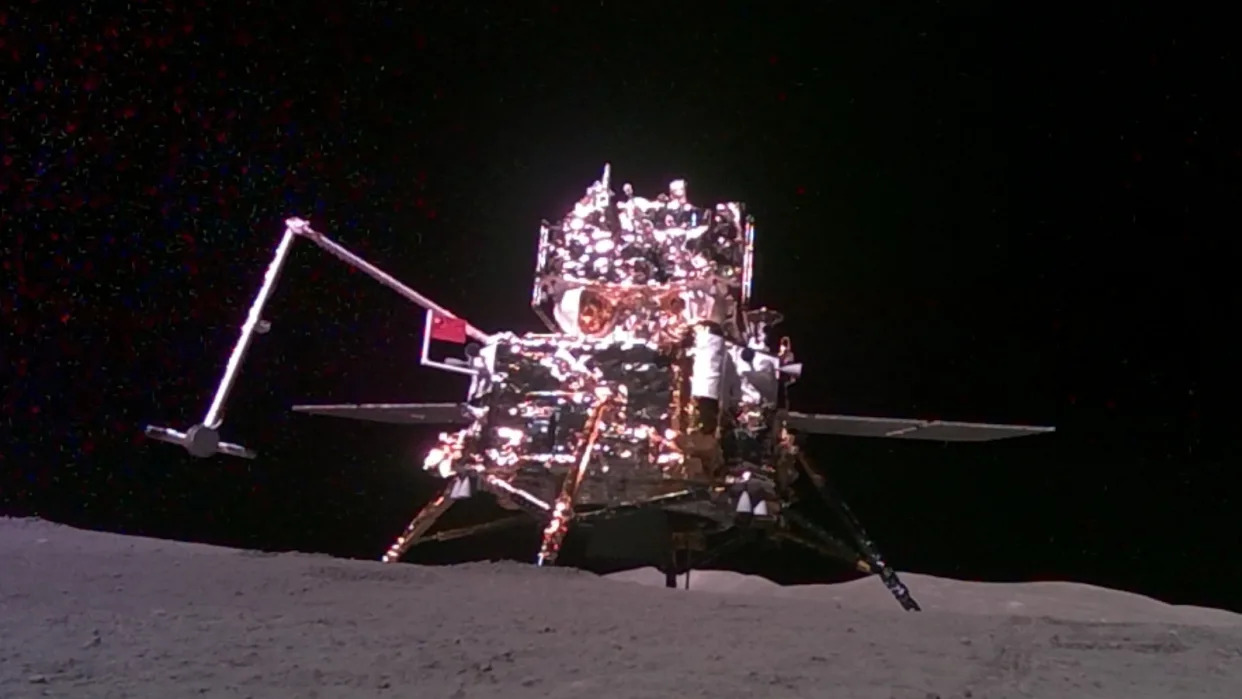
An image of China's Chang'e 6 lander on the moon's far side, snapped by the mission's minirover. | Credit: CNSA
China has revealed details about a miniature rover tucked away on the country's pioneering Chang'e 6 lunar far side sample-return mission.
Chang'e 6 launched on May 3 on a Long March 5 rocket. While being a repurposed backup to the successful 2020 Chang'e 5 mission, it was revealed after launch that the new spacecraft also packed a surprise rover.
The Chang'e 6 lander touched down in Apollo crater with the South Pole-Aitken basin on June 1. The rover was deployed around two days later, after sampling operations on the moon had been completed.
The small, autonomous vehicle drove away from its parent craft and snapped an iconic image of the lander, topped with an ascent vehicle which would later blast the collected samples into lunar orbit. The image shows solar arrays, landing legs, a deployed sampling arm and a basalt Chinese flag.
The rover is highly capable and has significantly enhanced autonomous intelligence, stated its developer, the China Aerospace Science and Technology Corporation (CASC), according to the state-run media outlet Xinhua.
The rover autonomously detached from the lander, drove to a suitable position and selected an ideal angle for the photograph before capturing the image, according to the report.
The small vehicle represents "a significant stride forward in the development of autonomous intelligence in China's deep space exploration endeavors, promising a positive influence on future lunar exploration," according to CASC.
At approximately 11 pounds (5 kilograms), the rover is much smaller and lighter than China's first two moon rovers: Yutu and Yutu 2, part of the 2013 near side Chang'e 3 and 2019 far side Chang'e 4 missions, respectively. Each Yutu weighed around 310 pounds (140 kg). Yutu 2 is still active inside the moon's Von Kármán crater.
RELATED STORIES:
— China launches Chang'e 6 sample-return mission to moon's far side (video)
— China's Chang'e 6 mission carried a stone flag to the moon's far side
— Why is the far side of the moon so weird? Scientists may have solved a lunar mystery
While China has not provided details, the Chang'e 6 lander and rover likely ceased operations when the ascent vehicle lifted off from atop the lander, blasting it with high-velocity exhaust. In any case, the lander and rover were not designed to survive the deep cold of lunar night that has since fallen over Apollo crater.
Chang'e 6 has been supported by Queqiao 2. The relay satellite bounced signals between ground teams and the spacecraft on the far side of the moon, which never faces Earth.
Chang'e 6 is expected to deliver around 4.4 pounds (2 kilograms) of precious lunar far side samples to Earth around June 25.
Andrew Jones
Fri, June 14, 2024

An image of China's Chang'e 6 lander on the moon's far side, snapped by the mission's minirover. | Credit: CNSA
China has revealed details about a miniature rover tucked away on the country's pioneering Chang'e 6 lunar far side sample-return mission.
Chang'e 6 launched on May 3 on a Long March 5 rocket. While being a repurposed backup to the successful 2020 Chang'e 5 mission, it was revealed after launch that the new spacecraft also packed a surprise rover.
The Chang'e 6 lander touched down in Apollo crater with the South Pole-Aitken basin on June 1. The rover was deployed around two days later, after sampling operations on the moon had been completed.
The small, autonomous vehicle drove away from its parent craft and snapped an iconic image of the lander, topped with an ascent vehicle which would later blast the collected samples into lunar orbit. The image shows solar arrays, landing legs, a deployed sampling arm and a basalt Chinese flag.
The rover is highly capable and has significantly enhanced autonomous intelligence, stated its developer, the China Aerospace Science and Technology Corporation (CASC), according to the state-run media outlet Xinhua.
The rover autonomously detached from the lander, drove to a suitable position and selected an ideal angle for the photograph before capturing the image, according to the report.
The small vehicle represents "a significant stride forward in the development of autonomous intelligence in China's deep space exploration endeavors, promising a positive influence on future lunar exploration," according to CASC.
At approximately 11 pounds (5 kilograms), the rover is much smaller and lighter than China's first two moon rovers: Yutu and Yutu 2, part of the 2013 near side Chang'e 3 and 2019 far side Chang'e 4 missions, respectively. Each Yutu weighed around 310 pounds (140 kg). Yutu 2 is still active inside the moon's Von Kármán crater.
RELATED STORIES:
— China launches Chang'e 6 sample-return mission to moon's far side (video)
— China's Chang'e 6 mission carried a stone flag to the moon's far side
— Why is the far side of the moon so weird? Scientists may have solved a lunar mystery
While China has not provided details, the Chang'e 6 lander and rover likely ceased operations when the ascent vehicle lifted off from atop the lander, blasting it with high-velocity exhaust. In any case, the lander and rover were not designed to survive the deep cold of lunar night that has since fallen over Apollo crater.
Chang'e 6 has been supported by Queqiao 2. The relay satellite bounced signals between ground teams and the spacecraft on the far side of the moon, which never faces Earth.
Chang'e 6 is expected to deliver around 4.4 pounds (2 kilograms) of precious lunar far side samples to Earth around June 25.
ADITHI RAMAKRISHNAN
Fri, June 14, 2024
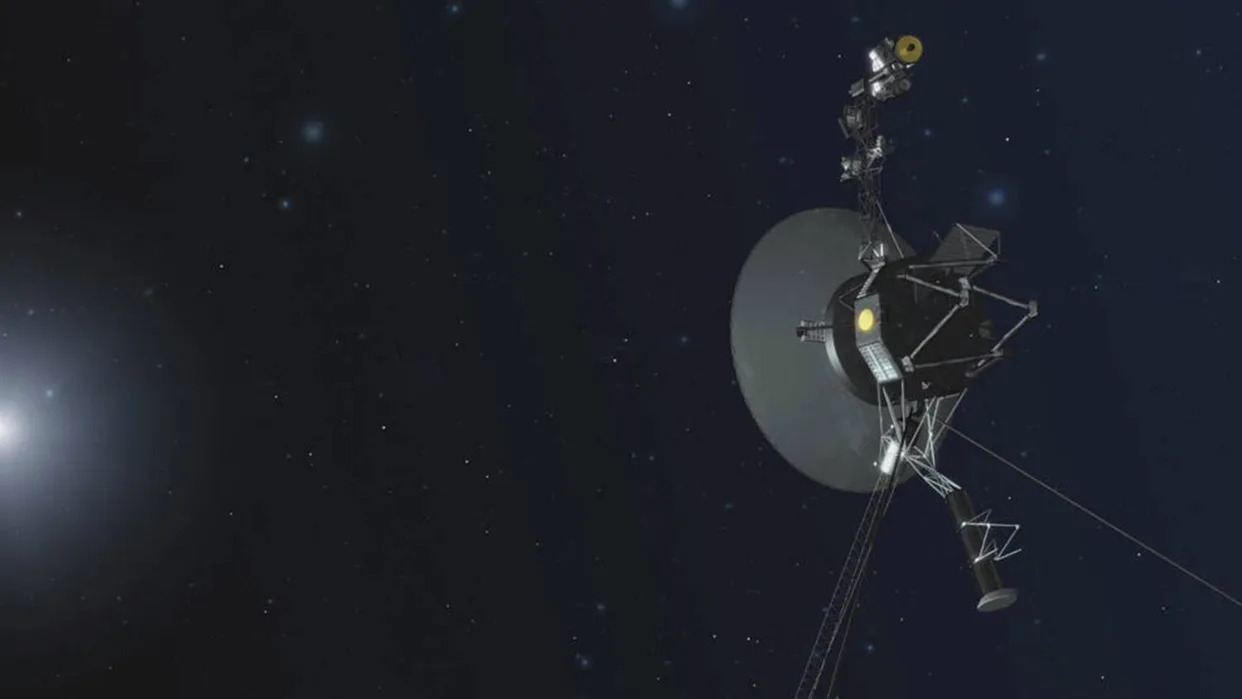
FILE - This illustration provided by NASA depicts Voyager 1. The most distant spacecraft from Earth stopped sending back understandable data in November 2023. The Jet Propulsion Laboratory in Southern California announced this week that Voyager 1's four scientific instruments are back in business after a technical snafu in November. (NASA via AP, File)
DALLAS (AP) — NASA's Voyager 1, the most distant spacecraft from Earth, is sending science data again.
Voyager 1's four instruments are back in business after a computer problem in November, the Jet Propulsion Laboratory said this week. The team first received meaningful information again from Voyager 1 in April, and recently commanded it to start studying its environment again.
Launched in 1977, Voyager 1 is drifting through interstellar space, or the space between star systems. Before reaching this region, the spacecraft discovered a thin ring around Jupiter and several of Saturn’s moons. Its instruments are designed to collect information about plasma waves, magnetic fields and particles.
Voyager 1 is over 15 billion miles (24.14 kilometers) from Earth. Its twin Voyager 2 — also in interstellar space — is more than 12 billion miles (19.31 kilometers) miles away.
—-
The Associated Press Health and Science Department receives support from the Howard Hughes Medical Institute’s Science and Educational Media Group. The AP is solely responsible for all content.
No comments:
Post a Comment